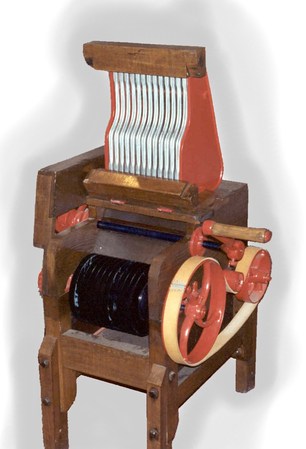Cotton Gin

This is the kind cotton they seperated seeds from.
Eli Whitney's invention of the cotton gin revolutionized the cotton industry in the United States. The cotton gin gave birth to the American mass-production. Prior to his invention, farming cotton required hundreds of hours to separate the cottonseed from the raw cotton fibers. Simple seed-removing machines have been around for centuries, however, Eli Whitney's invention automated the seed separation process. His machine could generate up to fifty pounds of cleaned cotton daily, making cotton production profitable for the southern states. Whitney failed to profit from his invention because imitations of his machine appeared. His 1794 patent for the cotton gin could not be held in court until 1807. He had a business partner named Phineas Miller. They had decided to get into the ginning business themselves. They manufactured as many cotton gins as possible and installed them throughout Georgia and the southern states.
Planters began making there own versions of Eli Whitney's gin and claiming they were, new, inventions. Phineas Miller brought costly suits against the owners of their own invention of the cotton gin.
The cotton gin is made by using two wheels that grabs the cotton. The other wheel grabs the cotton and the wheels are lined up left to right next to each other. This separated the cotton and half. This will also cause the seeds to come out or drop out of the cotton.
The part that was used to make the cotton gin was two wheels, canker, gears, wood, and many small parts that are interchangeable.
Before the invention was made people had to separate the cotton by them selves. This was a very long process. To make ten yards of cotton by hand would take at least a month like I said. After the cotton gin was invented it took less time of peoples lives.
Planters began making there own versions of Eli Whitney's gin and claiming they were, new, inventions. Phineas Miller brought costly suits against the owners of their own invention of the cotton gin.
The cotton gin is made by using two wheels that grabs the cotton. The other wheel grabs the cotton and the wheels are lined up left to right next to each other. This separated the cotton and half. This will also cause the seeds to come out or drop out of the cotton.
The part that was used to make the cotton gin was two wheels, canker, gears, wood, and many small parts that are interchangeable.
Before the invention was made people had to separate the cotton by them selves. This was a very long process. To make ten yards of cotton by hand would take at least a month like I said. After the cotton gin was invented it took less time of peoples lives.

